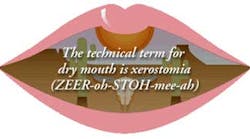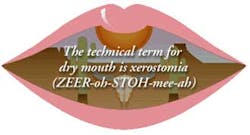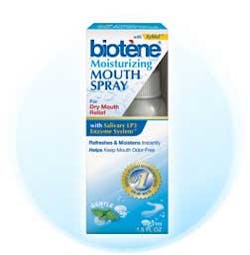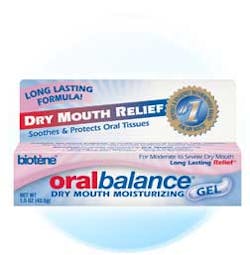Xerostomia is the medical term for the subjective complaint of dry mouth which may or may not be associated with a lack of saliva. A dry mouth can causes difficulty in speaking and swallowing, a burning or cracking tongue, cracked lips, mouth sores, reduction in the taste of flavors in food and drink, and pain.
Dry mouth can also lead to oral malodor, and sometimes a dramatic rise in the number of cavities. If the protective effect of saliva's remineralizing of enamel is no longer present, it can make the mucosa and periodontal tissues of the mouth more vulnerable to infection. Dry mouth occurs when the amount of saliva in the mouth becomes reduced. Saliva, with its proteins and enzymes, is essential for keeping the mouth lubricated and healthy. Dry mouth is a very common condition and affects more than 1 out of every 4 adults.(1,2) Diseases such as diabetes and Parkinson's disease can affect saliva, with the main autoimmune inflammatory disease being Sjögren's syndrome. Other causes of dry mouth include certain cancer treatments, such as radiation to the head and neck and damage to the glands' nerve system. Cancer treatment often requires procedures such as surgery, radiotherapy and chemotherapy, all of which can damage salivary tissue and may have a dramatic effect on salivary flow. In the most severe case, this can result in a total loss of salivary output. Many over-the-counter and prescription medicines can affect saliva flow. In fact, medications are the leading cause of dry mouth. Over 400 different medications have been associated with xerostomia.(1,3,4) and additionally taking more than one medication significantly increases the chance of having dry mouth. Common medications associated with dry mouth include: • Tricyclic antidepressants • Antipsychotics • Atropinics • Beta blockers • Antihistamines Proactive risk assessment for dry mouth should be incorporated into routine clinical practice by identification of symptoms through: • Medical History • Drug history • Subjective questioning on dry mouth symptoms • Clinical examination for oral signs Typical signs of xerostomia the oral health care professional may recognize include: • Dental mirror sticks to the tongue or buccal mucosa • No saliva pooling • Cervical caries • Frothy saliva • Altered gingival architecture (not only related to dry mouth) A more objective assessment tool is The Challacombe Scale, developed from research conducted at King’s College London Dental Institute under the supervision of Professor Stephen Challacombe.(6) The purpose of this scale is to be able to visually identify and quantify whether your patient has xerostomia (dry mouth) and if so, how it changes over time and the most appropriate therapy options. This scale is applicable to any profession. To download the Challacombe Scale Patient Review Form, click here. To download the Scale In English, click here.
Management of xerostomia includes products to lubricate or replace the enzymes in the saliva, and to protect the teeth. Biotène helps patients manage their dry mouth symptoms with products that soothe and moisturize (biotène spray, liquid and gel), products for daily cleaning (biotène toothpastes and oral rinses), and products that stimulate saliva (biotène gums).(5)
All biotène products have enzymes to help supplement some of saliva's natural enzymes that are depleted in a dry mouth. Patient brochures and a Bioténe Patient Hygiene Card: Over 400 medications can lead to symptoms of dry mouth are available at no charge.(7,8)
A.S. Pharma Saliva Orthana is a natural mucin-based saliva substitute available in the UK.(9) Fluorides are also very useful. Use of prescription medications, such as Evoxac (Cevimeline) or Salagen (Pilocarpine), are sometimes needed.
More information is available from the American Academy of Oral Medicine.(10), Procter & Gamble(11), Colgate, and Wrigley.
The incidence of dry mouth will grow over the coming years due to: • An Aging Population: The first of the post-war baby boomers have already reached their 65th birthday, and by 2050, one in five people in the U.S. will be over 65, while one in 20 will be over 85. Older people tend to take more medicines and are more likely to suffer disease—two of the common causes of dry mouth. • Obesity: One in three Americans is now obese. The growing number of obese Americans leads to the use of more medications that are likely to raise the incidence of dry mouth symptoms.References 1. Hupp WS. Xerostomia. Woman DentistJnl Feb. 8, 2008. 2. Guggenheimer J, Moore PA. Etiology, recognition and treatment. JADA 2003; 134:61-69. 3. Wind DA. Management of Xerostomia. An overview. Jnl Prac Hygiene Sept/Oct 1996:23-27. 4. ADA Guide to Dental Therapeutics, 4th Ed 2006. 5. BIOTÈNE is a registered trademark of Glaxo group of companies. http://www.dental-professional.com/Conditions_DryMouth_Products.aspx. 6. S Osailan et al “Investigating the relationship between hyposalivation and mucosal wetness“(2011) Oral Diseases volume 17, Issue 1, Pages: 109–114. 7. http://www.dental-professional.com/PDF/8.3.2_Biotene_patient_brochure.pdf. 8. http://www.dental-professional.com/PDF/8.3.2_Biotene_patient_hygiene_card.pdf. 9. http://www.aspharma.co.uk/. 10. http://www.aaom.com/patients/treatment-of-dry-mouth-xerostomia/. 11. http://www.dentalcare.com/en-US/dental-education/patient-education/xerostomia-english.aspx. 12. http://www.colgate.com/app/CP/US/EN/OC/Information/Articles/Oral-and-Dental-Health-Basics/Medical-Conditions/Dry-Mouth/article/Dry-Mouth.cvsp. 13. http://www.drymouth.info/practitioner/default.asp.











